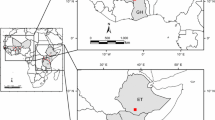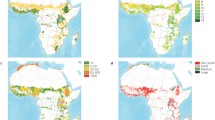Abstract
African countries, like Ethiopia, are particularly vulnerable to climate change because their economies largely depend on climate-sensitive agricultural production. Growth and Transformation Plan (GTP) of Ethiopia recognized climate change as a huge threat and focusing on mitigation issues. The GTP stipulates the country’s ambition to build a climate resilient green economy by 2030. This paper looks at the potential of livestock technologies and grazing land management for mitigation and adaption to a changing climate. Research findings in Ethiopia showed that livestock technologies and management of grazing lands such as improving the quality of forage, feeding highly digestible forages, processing and preservation of feeds, use of controlled grazing instead of continuous grazing and inclusion of legumes in forage mixes, have a great response to climate change. The choices for application of the technologies and potential mitigation strategies primarily depend on the adoption and cost associated with it. Grazing land management not only mitigates climate change but also reduces soil erosion, increases carbon sequestration and contributes to the resilience of crop-livestock farming systems in Ethiopia. In conclusion, management of grazing lands and implementation of livestock technologies have good implications in mitigating climate change on top of income generation and thereby improving the livelihood of farmers in Ethiopia.
Access this chapter
Tax calculation will be finalised at checkout
Purchases are for personal use only
Similar content being viewed by others
References
Abebe K (2017) Effect of climate change on nutritional supply to livestock production. Acad Res J Agri Sci Res 5(2):98–106
Abela LS (2005) The contribution of livestock production to drought vulnerability reduction in Mwingi district, Kenya. Doctoral dissertation, University of Nairobi, CEES, Kenya
Abberton MT, MacDuff JH, Marshall AH, Mike W (2007) The genetic improvement of forage grasses and legumes to reduce greenhouse gas emissions. A paper prepared by Humphreys from the plant breeding and genetics programme, Institute of Grassland and Environmental Research, Aberystwyth, United Kingdom in collaboration with the Plant Production and Protection Division, Crop and Grassland Service, of the Food and Agriculture Organization of the United Nations, Dec 2007
Adhikari U, Nejadhashemi AP, Woznicki SA (2015) Climate change and eastern Africa: a review of impact on major crops. Food and Energy Security 4 (2):110–132
Ahmed F, Alam GM, Al-Amin AQ, Hassan CHB (2013) The impact of climate changes on livestock sector: challenging experience from Bangladesh. Asian J Anim Vet Adv 8:29–40
Behnke R (2010) Trout and salmon of North America. Simon and Schuster, New York
Bannink A (2007) Feeding strategies to reduce methane loss in cattle. Rapport 34. 46 pagina’s, 6 figuren, 4 tabellen. Internet http://www.asg.wur.nl/po
Batjes NH (2004) Soil carbon stocks and projected changes according to land use and management: a case study for Kenya. Soil Use Manag 20(3):350–356
Boadi D, Benchaar C, Chiquette J, Massé D (2004) Mitigation strategies to reduce enteric methane emissions from dairy cows: update review. Can J Anim Sci 84(3):319–335
Bryan E, Ringler C, Okoba B, Koo J, Herrero M, Silvestri S (2011) Agricultural management for climate change adaptation, greenhouse gas mitigation, and agricultural productivity. IFPRI Discussion Paper 01098, June 2011. Insights from Kenya Environment and Production Technology Division
Calvosa C, Chuluunbaatar D, Fara K (2009) Livestock and climate change. Livestock thematic papers tools for project design. International fund for agricultural development. Via Paolo di Dono, 44, 00142 Rome, Italy. website at www.ifad.org/lrkm/index.htm
Climate change national adaptation programme of action (NAPA) of Ethiopia (2007) National Meteorological Services Agency, Ministry of Water Resources, Federal Democratic Republic of Ethiopia, Addis Ababa
Climate resilient green economy (CRGE) (2011) Ethiopia’s vision for a climate resilient green economy. Addis Ababa, Ethiopia, p 28
Central Statistical Authority (CSA) (2013) National population statistics. Federal Democratic Republic of Ethiopia, Addis Ababa
Conant RT, Paustian K (2002) Spatial variability of soil organic carbon in grasslands: implications for detecting change at different scales. Environ Pollut 116:S127–S135
Conant RT, Drijber RA, Haddix ML, Parton WJ, Paul EA, Plante AF, Six J, Steinweg JM (2015) Sensitivity of organic matter decomposition to warming varies with its quality. Glob Change Biol 14(4):868–877
Demir P, Bozukluhan K (2012) Economic losses resulting from respiratory diseases in cattle. J Anim Vet Adv 11:438–442
Environmental Protection Agency (EPA) (2011) Inventory of US greenhouse gas emissions and sinks: 1990–2009
Ethiopia’s Climate Resilient Green (ECRG) (2011) Green economy strategy. Addis Ababa, Ethiopia
Ethiopian Panel on Climate Change (EPCC) (2015) First assessment report, Working Group II Agriculture and Food Security. Published by the Ethiopian Academy of Sciences
Federal Democratic Republic of Ethiopia (FDRE) (2006) Poverty reduction strategy paper annual progress. IMF Country Report No. 06/27. https://www.imf.org/external/pubs/ft/scr/2006/cr0627.pdf
Ford CW, Morrison IM, Wilson JR (1979) Temperature effects on lignin, hemicelluloses and cellulose in tropical and temperate grasses. Aust J Agri Res 30(4):621–633
Getachew T (2015) Genetic diversity and admixture analysis of Ethiopian Fat-tailed and Awassi sheep using SNP markers for designing crossbreeding schemes. Doctoral dissertation, University of Natural Resources and Life Sciences, Vienna
Halderman M (2004) The political economy of pro-poor livestock policy-making in Ethiopia. Pro-poor livestock policy initiative working paper, 19
Hristov AN, Oh J, Lee C, Meinen R, Montes F, Ott T, Firkins J, Rotz A, Dell C, Adesogan A, Yang W, Tricarico J, Kebreab E, Waghorn G, Dijkstra J, Oosting S (2013) Mitigation of greenhouse gas emissions in livestock production—a review of technical options for non-CO2 emissions. In Gerber PJ, Henderson B, Makkar HPS (eds) FAO animal production and health paper no. 177. FAO, Rome, Italy
Hopkins A, Del Prado A (2007) Implications of climate change for grassland in Europe: impacts, adaptations and mitigation options: a review. Grass Forage Sci 62(2):118–126
Kassahun A, Snyman HA, Smit GN (2008) Impact of rangeland degradation on the pastoral production systems, livelihoods and perceptions of the Somali pastoralists in Eastern Ethiopia. J Arid Environ 72(7):1265–1281
Kassie M, Jaleta M, Shiferaw B, Mmbando F, Mekuria M (2013) Adoption of interrelated sustainable agricultural practices in smallholder systems: evidence from rural Tanzania. Technol Forecast Soc Chang 80(3):525–540
Kefyalew A, Tegegne F (2012) The effect of climate change on ruminant livestock population dynamics in Ethiopia. Bahir Dar University, college of agriculture and environmental sciences, department of animal production and technology, Bahir Dar, Ethiopia and Mizan-Tepi University, college of agriculture and natural resources, department of animal sciences, Ethiopia. Livestock Research for Rural Development
Khatri-Chhetria A, Aggarwal PK, Joshi PK, Vyasc S (2017) Farmers’ prioritization of climate-smart agriculture (CSA) technologies. Agric Syst 151:184–191
Klopfenstein TJ, Krause VE, Jones MJ, Woods W (1972) Chemical treatment of low quality roughages. J Anim Sci 35(2):418–422
Lipson J et al (2011) Implications of livestock series. Evans School Policy Analysis and Research. EPAR Brief, pp 155–157
Liu Z, Liu Y, Murphy J, Maghirang R (2017) Ammonia and Methane emission factors from cattle operations expressed as losses of dietary nutrients or energy. Agriculture 7(3):16
Mekuriaw S, Tegegn F, Mengistu A (2014) A review on reduction of greenhouse gas emission from ruminants through nutritional strategies. Acad J Environ Sci 2(1):006–014. http://www.academiapublishing.org/ajes
Nachmany M, Fankhauser S, Davidová J, Kingsmill N, Landesman T, Roppongi H, Schleifer P, Setzer J, Sharman A, Singleton CS, Sundaresan J, Townshend T (2015) Climate change legislation in Ethiopia. An excerpt from the 2015 global climate legislation study a review of climate change legislation in 99 Countries. www.lse.ac.uk/GranthamInstitute/legislation/
Ominski KH, Boadi DA, Wittenberg KM (2006) Enteric methane emissions from backgrounded cattle consuming all-forage diets. Can J Anim Sci 86(3):393–400
Oudshoorn FW (2009) Innovative technology and sustainable development of organic dairy farming: the case of automatic milking systems in Denmark
Pachauri RK, Allen MR, Barros VR, Broome J, Cramer W, Christ R, Church JA, Clarke L, Dahe Q, Dasgupta P, Dubash NK (2014) Climate change 2014: synthesis report. Contribution of Working Groups I, II and III to the fifth assessment report of the Intergovernmental Panel on Climate Change, p. 151, IPCC
Philander SG (ed) (2008) Encyclopedia of global warming and climate change. Sage, Beverley Hills
Pires AJV, Carvalho GGPD, Ribeiro LSO (2010) Chemical treatment of roughage. Revista Brasileira de Zootecnia, 39:192–203
Reed MS, Stringer LC, Dougill AJ, Perkins JS, Atlhopheng JR, Mulale K, Favretto N (2015) Reorienting land degradation towards sustainable land management: linking sustainable livelihoods with ecosystem services in rangeland systems. J Environ Manage 151:472–485
Rowlinson P (2008) Adapting livestock production systems to climate change-temperate zones. In Proceedings of the livestock and global change conference, Tunisia, 25 May 2008
Seré C, van der Zijpp A, Persley G, Rege E (2008) Dynamics of livestock production systems, drivers of change and prospects for animal genetic resources. Anim Genet Resour Inf 42:3–24
Sejian V, Gaughan J, Baumgard L, Prasad C (eds) (2015) Climate change impact on livestock: adaptation and mitigation. Springer India, New Delhi
Sidahmed AE, Nefzaoui A, El-Mourid M (2008) Livestock and climate change: coping and risk management strategies for a sustainable future. In Livestock and global change, pp 27–28
Somorin OA (2010) Climate impacts, forest-dependent rural livelihoods and adaptation strategies in Africa: a review. Afr J Environ Sci Technol 4(13):903–912
Steinfeld H, Gerber P (2010) Livestock production and the global environment: consume less or produce better? Proc Natl Acad Sci 107(43):18237–18238
Takele R, Gebretsidik S (2015) Prediction of long-term pattern and its extreme event frequency of rainfall in Dire Dawa Region, Eastern Ethiopia. J Climatol Weather Forecast pp 1–15
Tesfaye A, Chairatanayuth P (2007) Management and feeding systems of crop residues: the experience of East Shoa Zone, Ethiopia. Livestock Res Rural Dev 19(3):6–12
Thornton PK, Herrero M (2010) Potential for reduced methane and carbon dioxide emissions from livestock and pasture management in the tropics. Proc Natl Acad Sci 107(46):19667–19672
Thornton PK, van de Steeg J, Notenbaert A, Herrero M (2009) The impacts of climate change on livestock and livestock systems in developing countries: a review of what we know and what we need to know. Agric Syst 101(3):113–127
Tubiello F (2012) Climate change adaptation and mitigation: challenges and opportunities in the food sector. Natural Resources Management and Environment Department, FAO, Rome. Prepared for the High-level conference on world food security: the challenges of climate change and bioenergy, Rome, 3–5 June 2008
Ulyatt MJ, Lassey KR (2005) Methane emissions from pastoral systems: the situation in New Zealand. Archivos Latinoamericanos de Producción Animal, 9(2)
Urquhart P (2009) IFAD’s response to climate change through support to adaptation and related actions. Comprehensive report: final version, International Fund for Agricultural Development (IFAD), Rome, Italy. https://www.uncclearn.org/sites/default/files/inventory/ifad71.pdf
Wang JY, Lan ZR, Zhang XM (2012) Advances in molecular breeding research of goat fecundity. J Anim Vet Adv 11:449–453
Author information
Authors and Affiliations
Corresponding author
Editor information
Editors and Affiliations
Rights and permissions
Copyright information
© 2019 Springer Nature Switzerland AG
About this chapter
Cite this chapter
Mekuriaw, S., Mengistu, A., Tegegne, F. (2019). Livestock Technologies and Grazing Land Management Options for Climate Change Adaption and Mitigation as a Contribution for Food Security in Ethiopia: A Brief Overview. In: Castro, P., Azul, A., Leal Filho, W., Azeiteiro, U. (eds) Climate Change-Resilient Agriculture and Agroforestry. Climate Change Management. Springer, Cham. https://doi.org/10.1007/978-3-319-75004-0_22
Download citation
DOI: https://doi.org/10.1007/978-3-319-75004-0_22
Published:
Publisher Name: Springer, Cham
Print ISBN: 978-3-319-75003-3
Online ISBN: 978-3-319-75004-0
eBook Packages: Earth and Environmental ScienceEarth and Environmental Science (R0)




